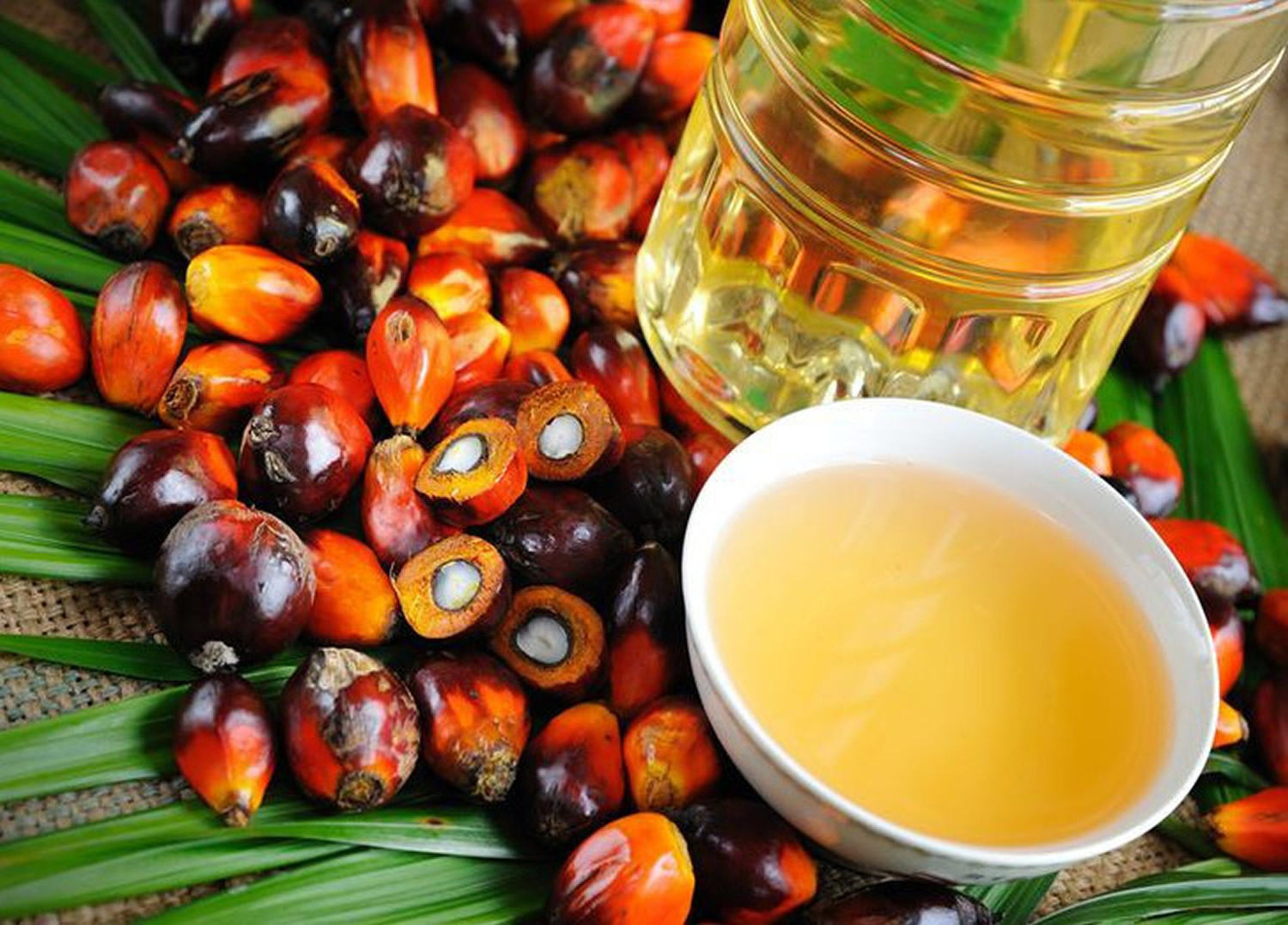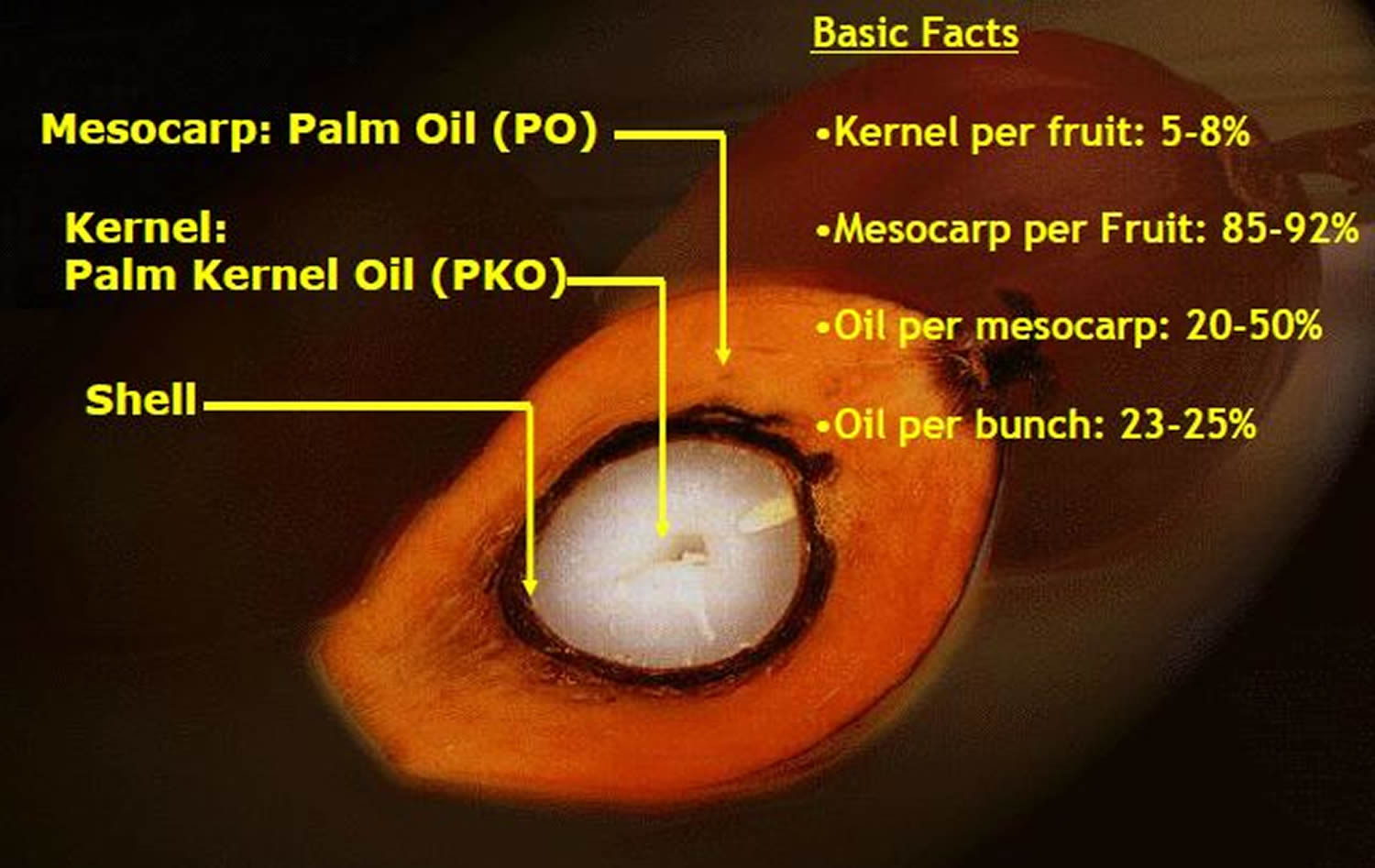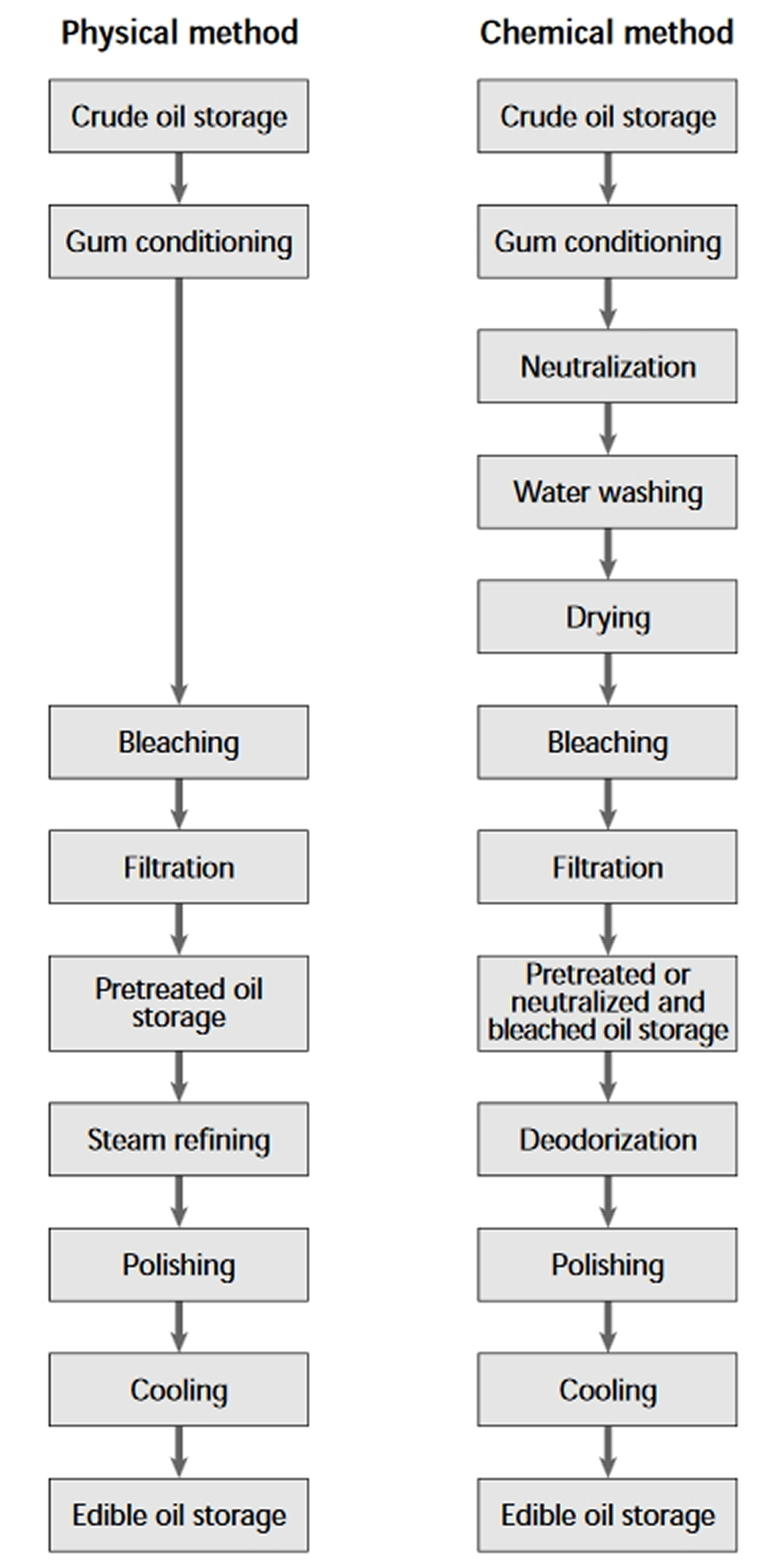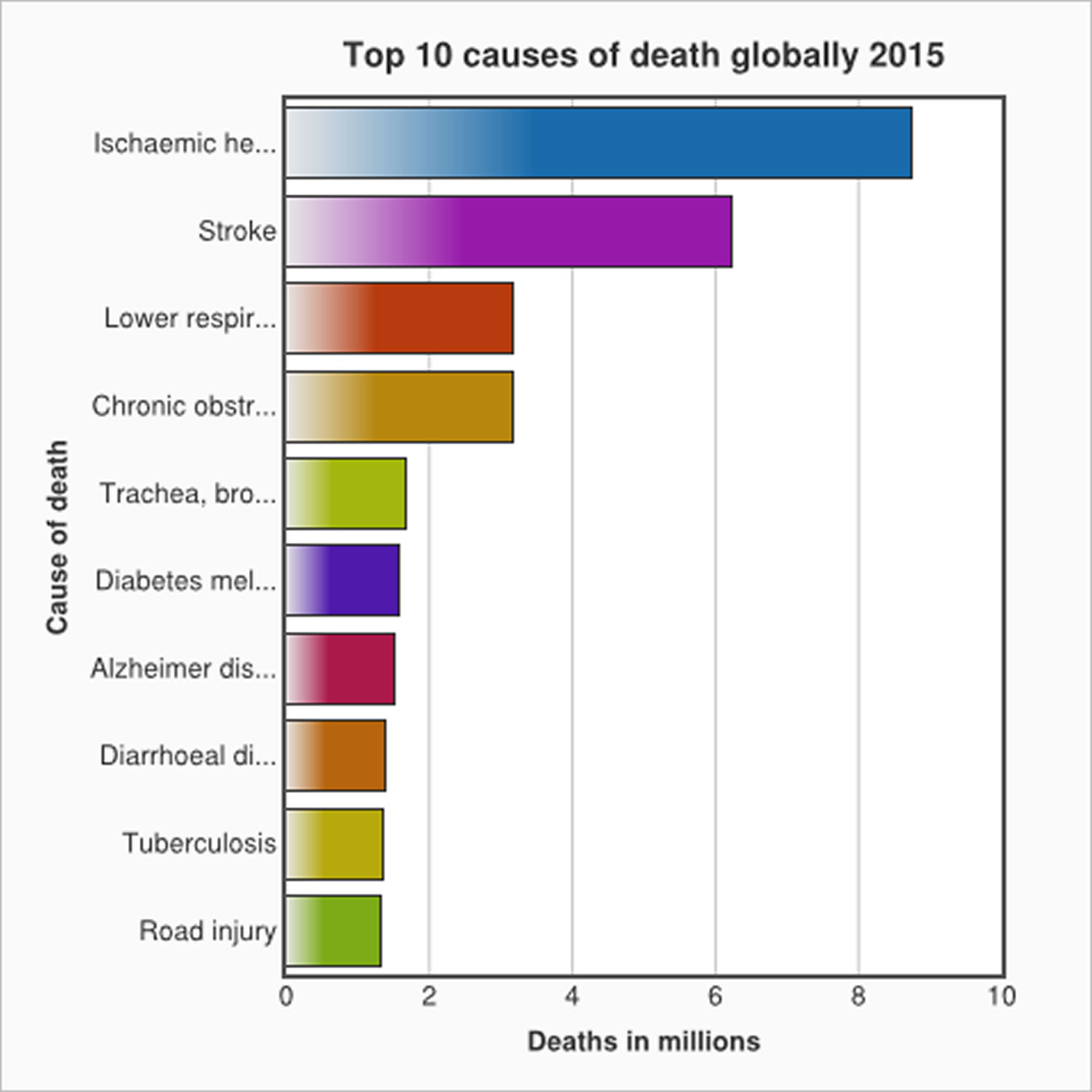Contents
What is palm oil ?
Palm oil is an edible vegetable oil derived from the mesocarp (reddish pulp) of the fruit of the oil palms. The oil palm tree belongs to the genus Elaeis. The genus Elaeis has two species: E. guineensis and E. oleifera. The former is found mainly in West Africa, particularly in Nigeria and was propagated to Malaysia, Brazil, and Indonesia by the Portuguese in the 19th century for commercial purposes. E. oleifera originated from South America and is a dwarfish plant 1. Unlike other oil-bearing crops, the oil palm is a unique crop in producing two oils from its fruit – palm oil from the fleshy mesocarp and palm kernel oil from the kernel 2. An oil palm usually bears fruits from 30 months after field planting. Being a perennial crop, it can be harvested round the year throughout its long productive lifespan (usually 25-30 years). This ensures that the supply of palm oil is uninterrupted.
Red palm oil is rich in carotenes, such as alpha-carotene, beta-carotene and lycopene, which give it a characteristic dark red color 3. However, palm oil that has been refined, bleached and deodorized from crude palm oil (called “RBD palm oil”) does not contain carotenes 4. Palm oil is not to be confused with palm kernel oil derived from the kernel of the same fruit or coconut oil derived from the kernel of the coconut palm (Cocos nucifera). The differences are in color (raw palm kernel oil lacks carotenoids and is not red), and in saturated fat content: palm mesocarp oil is 49% saturated, while palm kernel oil and coconut oil are 81% and 86% saturated fats, respectively. However, crude red palm oil that has been refined, bleached and deodorized, a common commodity called RBD (refined, bleached, and deodorized) palm oil, does not contain carotenoids 4.
Figure 1. Oil palm mesocarp (palm oil) and palm kernel (palm kernel oil)
Deforestation and environmental impacts of palm oil
Palm oil cultivation has been criticized for impacts on the natural environment, including deforestation, loss of natural habitats and loss of tropical biodiversity is also an issue, which has threatened critically endangered species such as the orangutan and Sumatran tiger and increased greenhouse gas emissions. Many palm oil plantations are built on top of existing peat bogs, and clearing the land for palm oil cultivation contributes to rising greenhouse gas emissions. For example, in Malaysia 15 percent of the country’s total land area has been transformed into palm oil plantations. The mass clearing of forest areas to create palm oil plantations has resulted in significant soil erosion, and palm oil mills also produce liquid effluents that end up in the water. Furthermore, palm oil mills also produce a certain amount of air pollution with most of the air and water pollution due to palm oil now comes from the refining of the oil, although occasionally the air pollution is caused by the burning of trees in order to clear land for plantations, or the burning of old palm oil trees for replanting.
Why crude palm oil undergoes a refining process ?
Some of the non-glyceride components in crude palm oil, such as free fatty acids, moisture and impurities and trace metals, are detrimental to the stability of the
oil, whereas odoriferous compounds reduce its palatability. The crude palm oil, therefore, needs to undergo a refining process in which the undesirable compounds are removed, thus rendering the oil more stable. Crude palm oil may undergo either physical or chemical refining, the former being the more common refining method in Malaysian palm oil refineries. Both processes involve high-temperature deodorization and deacidification under vacuum. Deodorization and deacidification in physical refining is usually carried out at temperatures of 250° to 270°C under vacuum of 3 to 5 torr, whereas chemical refining may be carried out at slightly lower temperatures of 220° to 240°C 5. The high temperature and vacuum used during deodorization and deacidification are necessary for the removal of as much of the undesirable components as possible (free fatty acids, oxidation and decomposition products, etc.). Unfortunately, these conditions also result in the removal of some of the tocopherols and tocotrienols and the destruction of all the carotenoids present in crude palm oil. A modified physical refining process, which produces a refined palm oil of similar quality to that of refined, bleached, and deodorized (RBD) palm oil while retaining most of the carotenoids and the vitamin E originally present in crude palm oil, has been
developed 6.
Figure 2. Crude palm oil refining processes
[Source 4]Along with coconut oil, palm oil is one of the few highly saturated vegetable fats and is semisolid at room temperature 7. From table 1 below, palm oil is 49.3% saturated fat, 37% monounsaturated and 9.30% polyunsaturated fatty acids. Palm oil is naturally reddish in color and for thousands of years palm oil has been a major source of cooking oil in many communities in Asia and Africa 1. Its use in the commercial food industry in other parts of the world is widespread because of its lower cost and the high oxidative stability (due to its saturated fat content) of the refined product when used for frying. Palm oil is the most widely-used vegetable oil in the world. Palm oil and palm kernel oil represent 33 per cent of all of the world’s production of vegetable oils, with soybean oil—at 27 percent—its nearest competitor 8. Indonesia (50%) and Malaysia (35%) supply 85 per cent of the palm oil used globally.
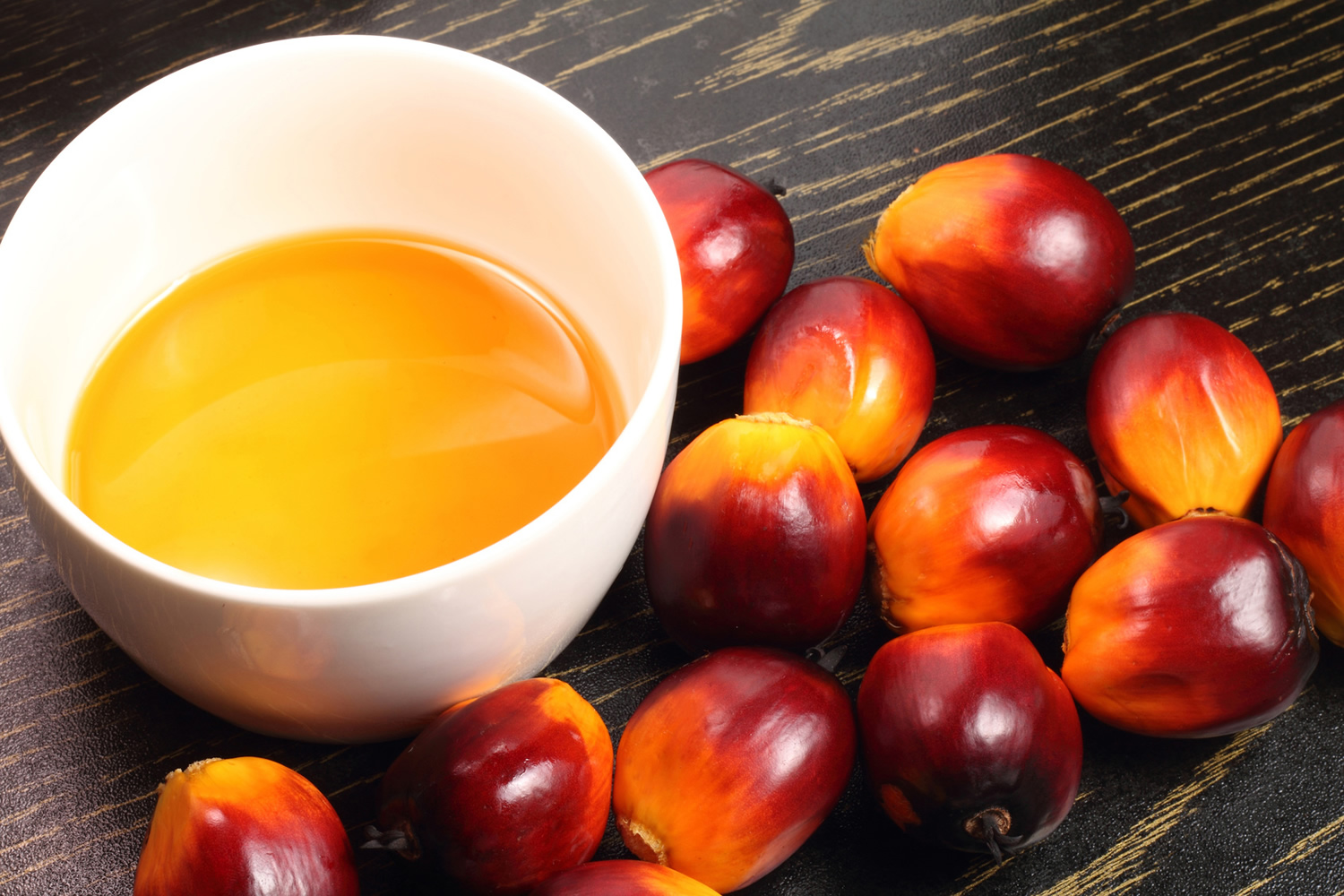
More than half the products on sale in the supermarket are made with palm oil. It is semi-solid at European and North American room temperatures and widely used by food and non-food manufacturers because of its low cost and favourable impact on taste and quality of end products. It is used as a natural ingredient in many food products, such as margarine, confectionery, chocolate, ice cream and bakery products, as well as nonfood products such as soap, candles, and cosmetics. One source reported that humans consumed an average 17 pounds (7.7 kg) of palm oil per person in 2015 9.
Table 1. Palm oil nutrition facts
Nutrient | Unit | Value per 100 g | 13.6 g | cup 216 g | 4.5 g | ||||||||||||||
|---|---|---|---|---|---|---|---|---|---|---|---|---|---|---|---|---|---|---|---|
| Approximates | |||||||||||||||||||
| Water | g | 0.00 | 0.00 | 0.00 | 0.00 | ||||||||||||||
| Energy | kcal | 884 | 120 | 1909 | 40 | ||||||||||||||
| Protein | g | 0.00 | 0.00 | 0.00 | 0.00 | ||||||||||||||
| Total lipid (fat) | g | 100.00 | 13.60 | 216.00 | 4.50 | ||||||||||||||
| Carbohydrate, by difference | g | 0.00 | 0.00 | 0.00 | 0.00 | ||||||||||||||
| Fiber, total dietary | g | 0.0 | 0.0 | 0.0 | 0.0 | ||||||||||||||
| Sugars, total | g | 0.00 | 0.00 | 0.00 | 0.00 | ||||||||||||||
| Minerals | |||||||||||||||||||
| Calcium, Ca | mg | 0 | 0 | 0 | 0 | ||||||||||||||
| Iron, Fe | mg | 0.01 | 0.00 | 0.02 | 0.00 | ||||||||||||||
| Magnesium, Mg | mg | 0 | 0 | 0 | 0 | ||||||||||||||
| Phosphorus, P | mg | 0 | 0 | 0 | 0 | ||||||||||||||
| Potassium, K | mg | 0 | 0 | 0 | 0 | ||||||||||||||
| Sodium, Na | mg | 0 | 0 | 0 | 0 | ||||||||||||||
| Zinc, Zn | mg | 0.00 | 0.00 | 0.00 | 0.00 | ||||||||||||||
| Vitamins | |||||||||||||||||||
| Vitamin C, total ascorbic acid | mg | 0.0 | 0.0 | 0.0 | 0.0 | ||||||||||||||
| Thiamin | mg | 0.000 | 0.000 | 0.000 | 0.000 | ||||||||||||||
| Riboflavin | mg | 0.000 | 0.000 | 0.000 | 0.000 | ||||||||||||||
| Niacin | mg | 0.000 | 0.000 | 0.000 | 0.000 | ||||||||||||||
| Vitamin B-6 | mg | 0.000 | 0.000 | 0.000 | 0.000 | ||||||||||||||
| Folate, DFE | µg | 0 | 0 | 0 | 0 | ||||||||||||||
| Vitamin B-12 | µg | 0.00 | 0.00 | 0.00 | 0.00 | ||||||||||||||
| Vitamin A, RAE | µg | 0 | 0 | 0 | 0 | ||||||||||||||
| Vitamin A, IU | IU | 0 | 0 | 0 | 0 | ||||||||||||||
| Vitamin E (alpha-tocopherol) | mg | 15.94 | 2.17 | 34.43 | 0.72 | ||||||||||||||
| Vitamin K (phylloquinone) | µg | 8.0 | 1.1 | 17.3 | 0.4 | ||||||||||||||
| Lipids | |||||||||||||||||||
| Fatty acids, total saturated | g | 49.300 | 6.705 | 106.488 | 2.219 | ||||||||||||||
| Fatty acids, total monounsaturated | g | 37.000 | 5.032 | 79.920 | 1.665 | ||||||||||||||
| Fatty acids, total polyunsaturated | g | 9.300 | 1.265 | 20.088 | 0.419 | ||||||||||||||
| Cholesterol | mg | 0 | 0 | 0 | 0 | ||||||||||||||
| Other | |||||||||||||||||||
| Caffeine | mg | 0 | 0 | 0 | 0 | ||||||||||||||
The major constituents of palm oil are triacylglycerols. The glycerol molecule is esterified with three fatty acids. During the process of palm oil extraction from the fleshy mesocarp of the fruit, triacylglycerols attract other fat-soluble cellular components. These include phosphatives, sterols, pigments, tocopherols, tocotrienols, monoglycerols, diglycerol and free fatty acids. The fatty acids are aliphatic acids like myristic, palmitic, stearic, linoleic acid. Palm oil also contains vitamins, antioxidants and other phytonutrients 2.
Palm oil has an especially high concentration of saturated fat, specifically the 16-carbon saturated fatty acid, palmitic acid, to which it gives its name. Monounsaturated oleic acid is also a major constituent of palm oil. Unrefined palm oil is a significant source of tocotrienol, part of the vitamin E family 11.
Table 2. The approximate concentration of fatty acids in palm oil
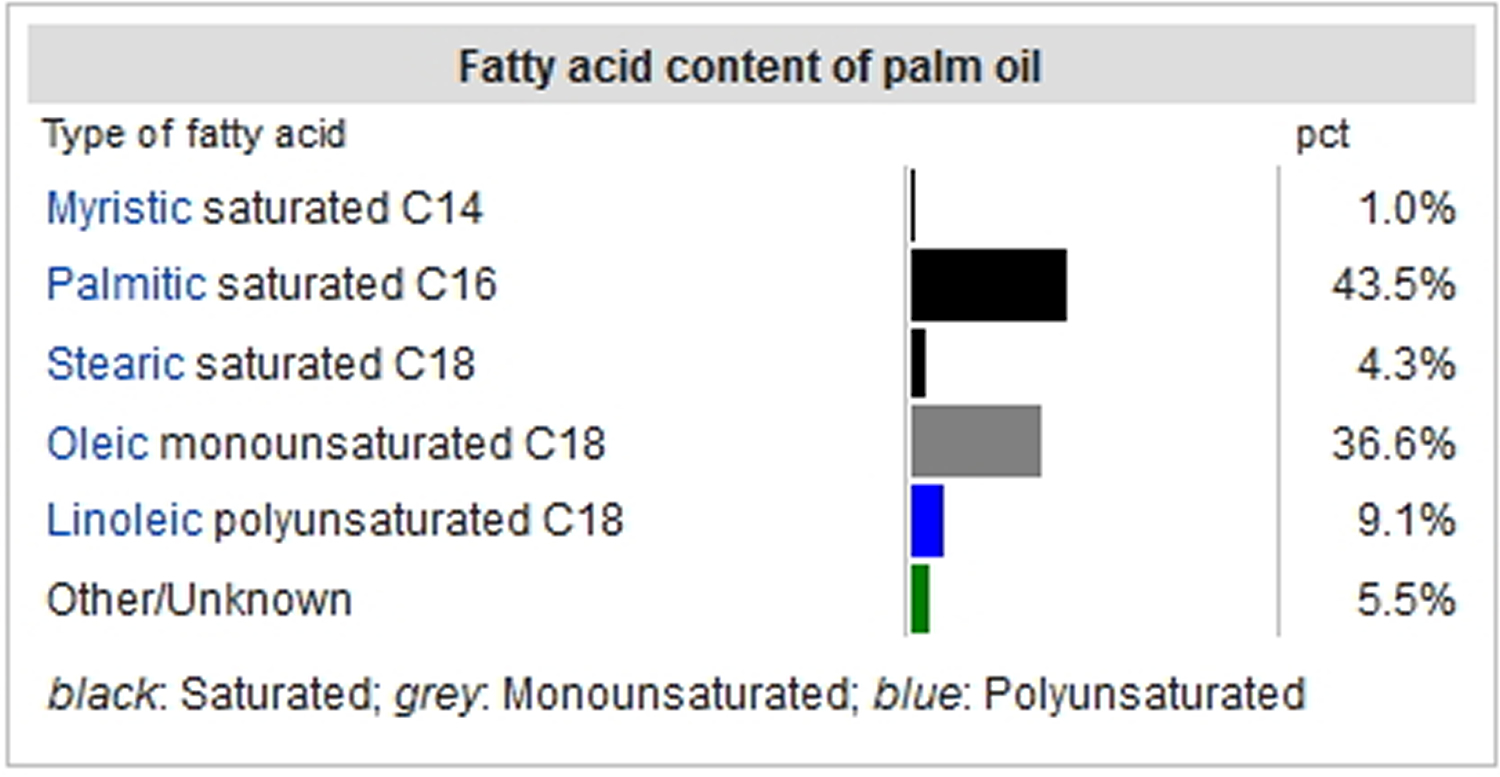
Note: Palm oil has almost equal parts saturated (50%) and unsaturated fatty acids (49%). Myristic acid (1%), stearic acid (5%) and palmitic acid (44%) make up the saturated fatty acid component in addition to monounsaturated oleic acid (39%), and polyunsaturated linoleic acid (11%) 13.
Palm oil and your health
Crude unrefined palm oil obtained from the mesocarp of the oil palm fruit consists mainly of glycerides and small quantities of non-glyceride components. The minor components in crude palm oil are carotenoids, tocopherols, tocotrienols, sterols, phospholipids, squalene, and tripterpenic and alipathic hydrocarbons 14. The carotenoids, tocopherols and tocotrienols are the most important of these minor components. Together, they contribute to the stability and nutritional properties of palm oil 15. Carotenoids impart the characteristic orange-red colour to crude palm oil. They also offer some oxidative protection by themselves being oxidized first, prior to the triglycerides 14. Carotenoids, in particular α- and β-carotene, are precursors of vitamin A that are converted into vitamin A in vivo. Tocopherols and tocotrienols are vitamin E isomers and are potent antioxidants that confer oxidative stability to the oil.
Palm oil consumption and its effects on serum lipid levels and cardiovascular disease in humans is still a subject of debate. The concern about palm oil is mainly because it contains palmitic acid, which is a saturated fatty acid and dietary intake of saturated fat increases serum cholesterol, will give rise to hypercholesterolemia when used as dietary oil 16. In 2012, the World Heart Organization listed ischaemic cardiovascular disease (coronary heart disease) as the leading cause of death worldwide 17. Ischaemic heart disease (coronary heart disease) and stroke are the world’s biggest killers, accounting for a combined 15 million deaths in 2015. These diseases have remained the leading causes of death globally in the last 15 years 17. The relationship between serum cholesterol and coronary heart disease risk is linear and dose dependent with a 20%-25% reduction in the risk of death from coronary heart disease and non-fatal heart attack as low-density lipoprotein (LDL “bad”) cholesterol decreases by 1.0 mmol/L 18. Palm oil consists of various fatty acids and this has been of major concern in discussing the value of palm oil vis-a-vis its relationship to cardiovascular disease 19, 20.
Figure 3. Top 10 causes of death globally 2015
[Source: World Health Organization 17]A study published in the November 2016 issue of the British Medical Journal 21 revealed findings that, saturated fat in the diet is associated with an increased risk of coronary heart disease. Moreover, the study offers a unique twist by teasing out the effects of different types of saturated fatty acids.
Butter, cheese, red meat, and full-fat dairy are high in saturated fat 21. Some plant-based fats like coconut and palm oil are also rich in saturated fat. However, all of these foods differ slightly in their relative proportions of individual saturated fatty acids. Commonly eaten saturated fatty acids include lauric, myristic, palmitic, and stearic. Coconut oil is richest in lauric acid, whereas butter is highest in palmitic acid; both contain smaller amounts of the other fatty acids.
The British Medical Journal study 21 examined the associations of individual and combined saturated fatty acids intake (lauric acid, myristic acid, palmitic acid, and stearic acid) with heart disease risk in more than 73,000 women from the Nurses’ Health Study and 42,000 men from the Health Professionals Follow-Up Study. Additionally, the researchers estimated the effects of replacing 1% of daily calories from these fatty acids with the same amount of calories from polyunsaturated fat, monounsaturated fat, whole grain carbohydrates, and plant proteins. There was an 18% greater risk of coronary heart disease in the group consuming the highest amounts of saturated fatty acids compared with the group consuming the least, with palmitic acid and stearic acid showing the highest risk 21. When replacing intake of individual saturated fatty acids, the greatest risk reduction was seen when replacing palmitic acid (found in palm oil, fatty cuts of red meat, and dairy fat) with plant proteins or polyunsaturated fat, with an 11% and 12% risk reduction, respectively 21.
Conclusion
Eating saturated fat like palm oil and palm kernel oil is bad because they are associated with increase risk of coronary heart disease and cardiovascular disease 22, 23, 24, 25. Heart and vascular disease includes heart attacks, angina, strokes, sudden cardiovascular death and the need for heart surgery. Numerous studies have found that a higher intake of the most commonly consumed major saturated fatty acids—lauric acid, myristic acid, palmitic acid, and stearic acid—was associated with a 18% increased relative risk of coronary heart disease. And replacing just 1% of daily consumption of these fatty acids with equivalent calories from polyunsaturated fats, whole grain carbohydrates, or plant proteins, was estimated to reduce relative coronary heart disease risk by 6%-8%. Replacing palmitic acid—found in palm oil, palm kernel oil, meat, and dairy fat—was associated with the strongest risk reduction. Eating good fats in place of saturated fat can also help prevent insulin resistance, a precursor to diabetes 26. So while saturated fat may not be as harmful as once thought, evidence clearly shows that unsaturated fat remains the healthiest type of fat. And replacing sources of saturated fat in your diets with unsaturated fats is one of the easiest ways to reduce our risk of heart disease.
Clinical trials data that examined the effects of individual saturated fatty acids on blood lipids. The results clearly demonstrated that, in comparison with carbohydrates, lauric acid, mystic acid, and palmitic acid raised low-density lipoprotein (LDL) cholesterol 27.
Saturated fat is mainly found in animal foods, but a few plant foods are also high in saturated fats, such as coconut, coconut oil, palm oil, and palm kernel oil.
- The Dietary Guidelines for Americans recommends getting less than 10 percent of calories each day from saturated fat 28.
- The American Heart Association goes even further, recommending limiting saturated fat to no more than 5 to 6 percent of calories 29.
- Cutting back on saturated fat will likely have no benefit, however, if people replace saturated fat with refined carbohydrates. Eating refined carbohydrates in place of saturated fat does lower “bad” LDL cholesterol, but it also lowers the “good” HDL cholesterol and increases triglycerides. The net effect is as bad for the heart as eating too much saturated fat 30.
In the United States, the biggest sources of saturated fat 31 in the diet are:
- Pizza and cheese
- Whole and reduced fat milk, butter and dairy desserts
- Meat products (sausage, bacon, beef, hamburgers)
- Cookies and other grain-based desserts
- Mexican fast food dishes
The overarching message is that cutting back on saturated fat can be good for health if people replace saturated fat with good fats, especially, polyunsaturated fats 32, 33, 34. Eating good fats in place of saturated fat lowers the “bad” LDL cholesterol, and it improves the ratio of total cholesterol to “good” HDL cholesterol, lowering the risk of heart disease 30.
- Public health nutrition concerns on consumption of red palm-oil (RPO): the scientific facts from literature. Oyewole OE, Amosu AM. Afr J Med Med Sci. 2010 Dec; 39(4):255-62; discussion 263-5. https://www.ncbi.nlm.nih.gov/pubmed/21735991/[↩][↩]
- Chemistry and biochemistry of palm oil. Sambanthamurthi R, Sundram K, Tan Y. Prog Lipid Res. 2000 Nov; 39(6):507-58. https://www.ncbi.nlm.nih.gov/pubmed/11106812/[↩][↩]
- Oi-Ming Lai, Chin-Ping Tan, Casimir C. Akoh (Editors) (2015). Palm Oil: Production, Processing, Characterization, and Uses. Elsevier. pp. 471, Chap. 16. ISBN 0128043466.[↩]
- Nagendran, B.; Unnithan, U. R.; Choo, Y. M.; Sundram, Kalyana (2000). “Characteristics of red palm oil, a carotene- and vitamin E–rich refined oil for food uses”. Food and Nutrition Bulletin. 21 (2): 77–82. http://journals.sagepub.com/doi/pdf/10.1177/156482650002100213[↩][↩][↩]
- Young FVK. The refining of palm oil. PORIM Technol 1981;1:1–44.[↩]
- Ooi CK, Choo YM, Ong ASH. Recovery of carotenoids. US Patent No. 5019668, 1991.[↩]
- Behrman, E. J.; Gopalan, Venkat (2005). William M. Scovell, ed. “Cholesterol and Plants”. Journal of Chemical Education. 82 (12): 1791. doi:10.1021/ed082p1791[↩]
- Roundtable on Environmental Health Sciences, Research, and Medicine; Board on Population Health and Public Health Practice; Institute of Medicine. The Nexus of Biofuels, Climate Change, and Human Health: Workshop Summary. Washington (DC): National Academies Press (US); 2014 Apr 2. 2, Case Study: The Palm Oil Example. Available from: https://www.ncbi.nlm.nih.gov/books/NBK196448/[↩]
- Che Man, YB; Liu, J.L.; Jamilah, B.; Rahman, R. Abdul (1999). “Quality changes of RBD palm olein, soybean oil and their blends during deep-fat frying”. Journal of Food Lipids. 6 (3): 181–193.[↩]
- United States Department of Agriculture Agricultural Research Service. National Nutrient Database for Standard Reference Release 28. https://ndb.nal.usda.gov/ndb/search/list[↩]
- Ahsan H, Ahad A, Siddiqui WA (2015). “A review of characterization of tocotrienols from plant oils and foods”. J Chem Biol. 8 (2): 45–59. PMC 4392014 Freely accessible. PMID 25870713. doi:10.1007/s12154-014-0127-8[↩]
- Oil, vegetable, palm per 100 g; Fats and fatty acids”. Conde Nast for the USDA National Nutrient Database, Release SR-21. 2014. http://nutritiondata.self.com/facts/fats-and-oils/510/2[↩]
- Sambanthamurthi R, Sundram K, Tan Y. Chemistry and biochemistry of palm oil. Prog Lipid Res. 2000;39:507–558. https://www.ncbi.nlm.nih.gov/pubmed/11106812[↩]
- Goh SH, Choo YM, Ong ASH. Minor constituents of palm oil. J Am Oil Chem Soc 1985;62:237–40.[↩][↩]
- Ooi CK, Choo YM, Yap CM, Ma AN. Refining of red palm oil. Elaeis 1996;8:20–8.[↩]
- Serum cholesterol response to changes in the diet: IV. Particular saturated fatty acids in the diet. Keys A, Anderson JT, Grande F. Metabolism. 1965 Jul; 14(7):776-87. https://www.ncbi.nlm.nih.gov/pubmed/25286466/[↩]
- World Health Organization. The top 10 causes of death. http://www.who.int/mediacentre/factsheets/fs310/en/[↩][↩][↩]
- Efficacy and safety of more intensive lowering of LDL cholesterol: a meta-analysis of data from 170,000 participants in 26 randomised trials. Cholesterol Treatment Trialists’ (CTT) Collaboration., Baigent C, Blackwell L, Emberson J, Holland LE, Reith C, Bhala N, Peto R, Barnes EH, Keech A, Simes J, Collins R. Lancet. 2010 Nov 13; 376(9753):1670-81. https://www.ncbi.nlm.nih.gov/pmc/articles/PMC2988224[↩]
- Oluba OM, Oyeneke CE. Effects of palm oil supplementation on lipid peroxidation and glutathione peroxidase activity in cholesterol fed rats. Internet journal of cardiovascular research. 2009;6:1.[↩]
- Keys A, Anderson JT, Grande F. Serum cholesterol response to changes in the diet: IV. Particular saturated fatty acids in the diet. Metabolism. 1965;14:776–787. https://www.ncbi.nlm.nih.gov/pubmed/25286466[↩]
- Zong, G., Li, Y., Wanders, A.J., Alssema, M., Zock, P.L., Willett, W.C., Hu, F.B., Sun, Q. Intake of individual saturated fatty acids and risk of coronary heart disease in US men and women: two prospective longitudinal cohort studies BMJ. 2016;355:i5796.[↩][↩][↩][↩][↩]
- Siri-Tarino, P.W., et al., Saturated fatty acids and risk of coronary heart disease: modulation by replacement nutrients. Curr Atheroscler Rep, 2010. 12(6): p. 384-90.[↩]
- Hu, F.B., et al., Dietary fat intake and the risk of coronary heart disease in women. N Engl J Med, 1997. 337(21): p. 1491-9.[↩]
- Ascherio, A., et al., Dietary fat and risk of coronary heart disease in men: cohort follow up study in the United States. BMJ, 1996. 313(7049): p. 84-90.[↩]
- Hu, F.B., J.E. Manson, and W.C. Willett, Types of dietary fat and risk of coronary heart disease: a critical review. J Am Coll Nutr, 2001. 20(1): p. 5-19.[↩]
- Riserus, U., W.C. Willett, and F.B. Hu, Dietary fats and prevention of type 2 diabetes. Prog Lipid Res, 2009. 48(1): p. 44-51.[↩]
- Mensink, R.P., Zock P.L., Kester, A.D., Katan, M.B. Effects of dietary fatty acids and carbohydrates on the ratio of serum total to HDL cholesterol and on serum lipids and apolipoproteins: a meta-analysis of 60 controlled trials. Am J Clin Nutr. 2003;77:1146-55.[↩]
- U.S. Department of Health and Human Services. 2015–2020 Dietary Guidelines for Americans. https://health.gov/dietaryguidelines/[↩]
- Lichtenstein, A.H., et al., Diet and lifestyle recommendations revision 2006: a scientific statement from the American Heart Association Nutrition Committee. Circulation, 2006. 114(1): p. 82-96.[↩]
- Harvard University. Harvard School of Public Health. Types of Fat. https://www.hsph.harvard.edu/nutritionsource/types-of-fat/[↩][↩]
- Institute, N.C., Risk Factor Monitoring and Methods: Table 1. Top Food Sources of Saturated Fat among U.S. Population, 2005–2006. NHANES.[↩]
- Mozaffarian, D., R. Micha, and S. Wallace, Effects on coronary heart disease of increasing polyunsaturated fat in place of saturated fat: a systematic review and meta-analysis of randomized controlled trials. PLoS Med, 2010. 7(3): p. e1000252.[↩]
- Astrup, A., et al., The role of reducing intakes of saturated fat in the prevention of cardiovascular disease: where does the evidence stand in 2010? Am J Clin Nutr, 2011. 93(4): p. 684-8.[↩]
- Farvid MS, Ding M, Pan A, Sun Q, Chiuve SE, Steffen LM, Willett WC, Hu FB. Dietary Linoleic Acid and Risk of Coronary Heart Disease: A Systematic Review and Meta-Analysis of Prospective Cohort Studies. Circulation, 2014.[↩]
